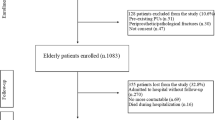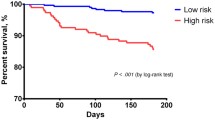Abstract
Background
Multidimensional Prognostic Index (MPI), calculated on cognitive, functional, nutritional, social, pharmacological and comorbidity domains, strongly correlates with mortality in older patients. Hip fractures are a major health problem and are associated with adverse outcomes in those affected by frailty.
Aim
We aimed at evaluating whether MPI is a predictor of mortality and rehospitalization in hip fracture older patients.
Methods
We investigated the associations of MPI with all-cause 3- and 6-month mortality and rehospitalization in 1259 older patients admitted for hip fracture surgical treatment and managed by an orthogeriatric team [age 85 years (65–109); male gender: 22%].
Results
Overall mortality was 11,4%, 17% and 23,5% at 3, 6 and 12 months from surgery (rehospitalizations: 15, 24,5 and 35,7%). MPI was associated (p < 0.001) with 3-, 6- and 12- month mortality and readmissions; Kaplan–Meier estimate for rehospitalization and survival according to MPI risk classes confirmed these results. In multiple regression analyses these associations were independent (p < 0.05) of mortality and rehospitalization-associated factors not included in the MPI, such as gender, age and post-surgical complications. Similar MPI predictive value was observed in patients undergoing endoprosthesis or other surgeries. ROC analysis confirmed that MPI was a predictor (p < 0.001) of both 3- and 6- month mortality and rehospitalization.
Conclusions
In hip fracture older patients, MPI is a strong predictor of 3-, 6- and 12- months mortality and rehospitalization, independently of surgical treatment and post-surgical complications. Therefore, MPI should be considered a valid pre-surgical tool to identify patients with higher clinical risk of adverse outcomes.


Similar content being viewed by others
Data availability
The datasets generated and analysed during the current study are available from the corresponding author on reasonable request.
Code availability
Not applicable.
References
Pioli G, Bendini C, Pignedoli P et al (2018) Orthogeriatric co-management – managing frailty as well as fragility. Injury 49:1398–1402. https://doi.org/10.1016/j.injury.2018.04.014
Chen CL, Chen CM, Wang CY et al (2019) Frailty is associated with an increased risk of major adverse outcomes in elderly patients following surgical treatment of hip fracture. Sci Rep 9:1. https://doi.org/10.1038/s41598-019-55459-2
Vitale E, Notarnicola A, Tafuri S et al (2014) Orthopedic multidimensional prognostic index (ortho-mpi) in the elderly with hip or neck femur fracture: A pilot study. Arch Gerontol Geriatr 58:101–104. https://doi.org/10.1016/j.archger.2013.08.006
Ikram A, Norrish AR, Marson BA et al (2022) Can the clinical frailty scale on admission predict 30day survival, postoperative complications, and institutionalization in patients with fragility hip fracture? Bone Joint J 8:980–986. https://doi.org/10.1302/0301-620X.104B8
Gandossi CM, Zambon A, Oliveri G et al (2021) Frailty, post-operative delirium and functional status at discharge in patients with hip fracture. Int J Geriatr Psychiatry. https://doi.org/10.1002/gps.5561
Forssten MP, Cao Y, Trivedi D et al (2022) Developing and validating a scoring system for measuring frailty in patients with hip fracture: A novel model for predicting short-term postoperative mortality. Trauma Surg Acute Care Open. https://doi.org/10.1136/tsaco-2022-000962
Choi JY, Cho K, Kim S et al (2017) Prediction of mortality and postoperative complications using the hip-multidimensional frailty score in elderly patients with hip fracture. Sci Rep. https://doi.org/10.1038/srep42966
Pizzonia M, Giannotti C, Carmisciano L et al (2021) Frailty assessment, hip fracture and long-term clinical outcomes in older adults. Eur J Clin Invest. https://doi.org/10.1111/eci.13445
Ercin E, Bilgili M, Sari C et al (2017) Risk factors for mortality in geriatric hip fractures: a compressional study of different surgical procedures in 785 consecutive patients. Euro J Orthop Surg Traumat 27:101. https://doi.org/10.1007/s00590-016-1843-2
Pilotto A, Ferrucci L, Franceschi M et al (2008) Development and validation of a multidimensional prognostic index for one-year mortality from comprehensive geriatric assessment in hospitalized older patients. Rejuvenation Res 11:151–161. https://doi.org/10.1089/rej.2007.0569
R Bernabei, V Venturiero, P Tarsitani et al (2000) The comprehensive geriatric assessment: when, where, how. [Online]. Available: www.elsevier.com/locate/critrevonc
Pilotto A, Rengo F, Marchionni N et al (2012) Comparing the prognostic accuracy for all-cause mortality of frailty instruments: A multicentre 1-year follow-up in hospitalized older patients. PLoS ONE. https://doi.org/10.1371/journal.pone.0029090
Pilotto A, Veronese N, Daragjati J et al (2019) Using the multidimensional prognostic index to predict clinical outcomes of hospitalized older persons: A prospective, multicenter, international study. JGerontol Series Biol Sci Med Sci 74:1643–1649. https://doi.org/10.1093/gerona/gly239
Bakas AT, Sewnaik A, Van Straaten J et al (2021) The multidimensional prognostic index as a measure of frailty in elderly patients with head and neck cancer. Clin Interv Aging 16:1679–1689. https://doi.org/10.2147/CIA.S323740
Musacchio C, Custodero C, Razzano M et al (2022) Association between multidimensional prognostic index (MPI) and pre-operative delirium in older patients with hip fracture. Sci Rep. https://doi.org/10.1038/s41598-022-20734-2
Katz S, Ford AB, Moskowitz RW et al (1963) Studies of Illness in the aged the index of ADL: A standardized measure of biological and psychosocial function. JAMA 185:914–919
Lawton MPB (1969) Assessment of older people: self-maintaining and instrumental activities of daily living. Gerontologist 9:179–186
Pfeiffer E (1975) A short portable mental status questionnaire for the assessment of organic brain deficit in elderly patients. J Am Geriatr Soc 23:1975. https://doi.org/10.1111/j.1532-5415.1975.tb00927.x
Guigoz Y, Vellas B (1999) The Mini Nutritional Assessment (MNA) for grading the nutritional state of elderly patients: presentation of the MNA, history and validation. Nest Nutrit workshop series Clin perform prog. https://doi.org/10.1159/000062967
Linn BS, Linn MW, Grel L (1968) Cumulative illness rating scale. J Am Geriatr Soc 16:622–626
Es MR, Bliss A, MR, (1966) Mattresses for preventing pressure sores in geriatric patients. Mon Bull Minist Health Public Health Lab Serv 25:238–268
Angleman SB, Santoni G, Pilotto A et al (2015) Multidimensional prognostic index in association with future mortality and number of hospital days in a population-based sample of older adults: results of the EU funded MPI-AGE project. PLoS ONE 10:1337. https://doi.org/10.1371/journal.pone.0133789
Chan S, Wong EKC, Ward SE (2019) The predictive value of the clinical frailty scale on discharge destination and complications in older hip fracture patients. J Orthop Trauma 33:497–502
Xu BY, Yan S, Low LL et al (2019) Predictors of poor functional outcomes and mortality in patients with hip fracture: A systematic review BMC. Musculosk Dis 20:1. https://doi.org/10.1186/s12891-019-2950-0
Krishnan M, Beck S, Havelock W et al (2014) Predicting outcome after hip fracture: Using a frailty index to integrate comprehensive geriatric assessment results. Age Ageing 43:122–126
Kistler EA, Nicholas JA, Kates SL et al (2015) Frailty and short-term outcomes in patients with hip fracture. Geriatr Orthop Surg Rehabil 6:209–214
Pilotto A, Custodero C, Maggi S et al (2020) A multidimensional approach to frailty in older people. Ageing Res Rev. https://doi.org/10.1016/j.arr.2020.101047
Stenvers E, Mars RC, Zuurmond RG (2019) Frail patients benefit from less invasive procedures. Geriatr Orthop Surg Rehabil. https://doi.org/10.1177/2151459319885283
Musacchio C, Razzano M, Raiteri R et al (2018) Time to surgery and multidimensional prognostic index (MPI) in older patients with hip fracture. Eur Geriatr Med 9:S310
Fortes-Filho SQ, Apolinario D, Melo JA et al (2016) Predicting delirium after hip fracture with a 2-min cognitive screen: Prospective cohort study. Age Ageing 45:712. https://doi.org/10.1093/ageing/afw084
Endo A, Baer HJ, Nagao M et al (2018) Prediction model of in-hospital mortality after hip fracture surgery. J Orthop Trauma. https://doi.org/10.1097/BOT.0000000000001026
Funding
No funding was received to conduct this study. The authors have no relevant financial or non-financial interests to disclose.
Author information
Authors and Affiliations
Contributions
MZ, PDC and RB contributed to the study conception and design. Material preparation, data collection and clinical activity on patients were performed by PDC. MZ and MN wrote and revised the article. RB examined the text, suggesting ideas for setting and focusing on the main aspects mentioned in the article. GGC performed the statistic analysis. CR and LM performed the surgeries. All authors commented on previous versions of the manuscript. All authors read and approved the final manuscript.
Corresponding author
Ethics declarations
Conflict of interest
The authors have no conflict of interest to declare.
Human and animal rights
The study was conducted according to the guidelines included in the Declaration of Helsinki involving human patients.
Informed consent
Written informed consent for data access and use for research purposes was provided by either the patient or a nominated proxy.
Additional information
Publisher's Note
Springer Nature remains neutral with regard to jurisdictional claims in published maps and institutional affiliations.
Supplementary Information
Below is the link to the electronic supplementary material.
Rights and permissions
Springer Nature or its licensor (e.g. a society or other partner) holds exclusive rights to this article under a publishing agreement with the author(s) or other rightsholder(s); author self-archiving of the accepted manuscript version of this article is solely governed by the terms of such publishing agreement and applicable law.
About this article
Cite this article
Zanetti, M., De Colle, P., Niero, M. et al. Multidimensional prognostic index predicts short- and long-term mortality and rehospitalizations in older patients with hip fracture. Aging Clin Exp Res 35, 1487–1495 (2023). https://doi.org/10.1007/s40520-023-02433-8
Received:
Accepted:
Published:
Issue Date:
DOI: https://doi.org/10.1007/s40520-023-02433-8




